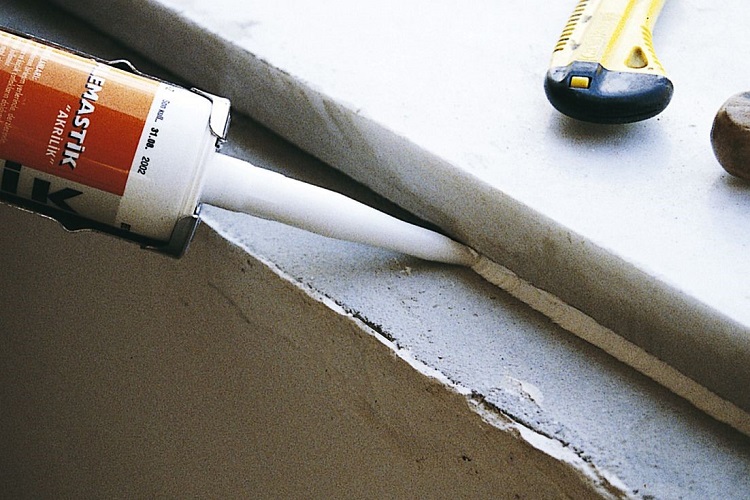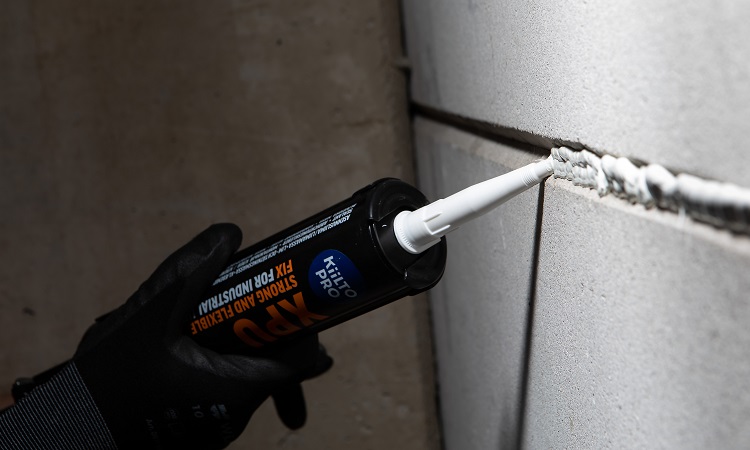If you’re doing some soundproofing work at home, you’ll need to make sure the job is finished correctly to get the best results.
Acoustic sealant is an essential final step in all soundproofing jobs and without its application, all of your previous efforts become meaningless.
What is an acoustic sealant used for?
Acoustic sealant is a material used to fill in the gaps and cracks of any building material, with special acoustic qualities that make it different from the regular caulk.
This sealant stays soft and pliable so it helps to absorb sound and it’s used as a last line of defense when trying to soundproof a room or house.
To get the lowdown on this critical step of soundproofing, we’ve answered all of the pressing questions about the acoustic sealant. We’ll show you where to use it for the best results, how the product works, and why it’s a must-have when you’re performing acoustic treatments at home.
What Is Acoustic Sealant?

Acoustic sealant is a product designed to create a soundproofing barrier. It’s applied to cracks, gaps, and crevices just as you would with standard caulk, but as well as being a sealant, it provides a barrier against sound.
When compared to regular caulk, acoustic sealant has quite a few differences, but because of its special qualities, it’s also more expensive and only suited for specialist applications.
Where soundproofing is needed. The unique formula works on all types of most types of building materials, has no odor, is non-toxic and non-flammable, and most importantly, it blocks sound.
Upon application and after drying, acoustic sealant turns to a rubbery type of material and it’s flexible enough to handle the expansions and contractions of whatever it’s attached to.
If you have any gaps in windows, doors, walls, or other spaces where sound can travel, a simple application of acoustic sealant is enough to prevent sound escaping.
How Does It Work?
Acoustic sealant is an effective soundproofing measure, which works because of the unique materials that make it differ from regular caulks and sealant.
This sealant takes the form of a latex adhesive that goes on in a semi-liquid state and then hardens to a harder, rubbery feel once it’s dried completely.
The sealant is placed into gaps and cracks where sound might usually leak, including around windows and when joining two sheets of drywall together.
Rather than allowing the sound waves to travel through, the acoustic caulk absorbs them first so what’s left is minimal. It also absorbs the vibration that’s created from the sound in the room as well, giving it a two-pronged attack when used for soundproofing.
The application of an acoustic sealant is easy, but you should always follow the specific instructions of the brand you’ve purchased.
It’s applied like regular caulk from a gun with a trigger that allows the sealant to be released slowly, and you’ll need to give it at least 48 hours to dry before moving onto the next phase.
The Best Uses for Acoustic Sealant
The application possibilities for acoustic sealant are varied, but the overall goal of its use is to soundproof a room.
With that in mind, there are quite a few places in a single room that you can apply it, and the more you’re able to use it, the better soundproofing results you’ll get.
- Drywall
If you’re putting up new drywall, acoustic caulk can be applied between the seams of each sheet. This helps keep sound waves from traveling through the interior walls of a house.
For applications where two layers of drywall are being installed, there’s no need to apply an acoustic sealant to every joint, so just one side of the sheets will do.
- Doors
A quick look at any of the doors in your house will show you the possibilities for soundwaves to escape.
Using your acoustic sealant, you can work around the edges of the door to seal up any cracks and create a soundproofing barrier for that room, but you must take off the moldings first to get the source of the problem.
- Floors
Applying a coat of acoustic sealant around the perimeter of the floors in a room, or an entire house, can prevent sound from escaping.
Although people don’t realize the potential for sound to travel on this level, it’s one of the biggest potential leaks for soundwaves, but also helps to keep temperatures maintained.
- Windows
Check around the windows of the room you want to soundproof for potential cracks and crevices, and apply a layer of acoustic sealant to them.
You’ll need to remove any moldings or windowsills from around the window to enable you to get to the gaps underneath where soundwaves travel.
- Wiring
Anywhere in the home where wiring is present, like electrical boxes or recessed lighting, can have acoustic sealant applied to keep the soundwaves inside the room. This should be done before the plates are applied to seal the insides where sound waves can escape from.
Acoustic sealant has been designed for longevity so you’ll only have to replace it if you see a crack or gap in the rubbery material, and even then, you can just fix the problem area.
However, if you need to replace it completely or remove some from a surface, you can use mineral spirits or xylene to wipe it away without leaving a trace.
Seal the Gaps for Minimal Sound

When you’re implementing soundproofing measures around the home, it makes sense to use an acoustic sealant to finish the job.
With a single application of this pliable type of caulk, you’ll keep air and sound from escaping or getting in, and have a long-lasting barrier against noise leaks.
Related Questions
Acoustic sealant is just one line of defense against noise, and though it might seem small, it has a lot of impact on the acoustics and sound barriers of a room.
If you’ve been thinking about soundproofing a room or your entire home, there’s a lot to learn, so read on to see some FAQs and our answers that can help you out.
What Material Can Block Sound?
Choosing sound-blocking materials in a space can assist when you’re trying to soundproof a room, so look for items like mass-loaded vinyl, acoustic caulk, soundproofing spray foam, and anything soft and pliable.
These will effectively block or absorb soundwaves and increase the soundproof factor of a room, compared to hard surfaces that merely reflect the soundwaves.
What Is the Cheapest Way to Soundproof a Wall?
If you’re trying to soundproof a specific wall at home for cheap, you can apply a dense mass to it like a carpet, seal up any gaps or cracks with acoustic caulk, and add more curtains or covers over the windows.
These cheap fixes target areas where sound is more likely to escape and can improve its soundproof rating.
Does Green Glue Work For Soundproofing?
The standard Green Glue product was not designed to be a soundproofing material, even though it can provide a minimal amount of noise dampening in the right application and with low-frequency noise.
However, Green Glue has created a dedicated acoustic sealant that will achieve better results if you’re trying to soundproof a room.
Resources
